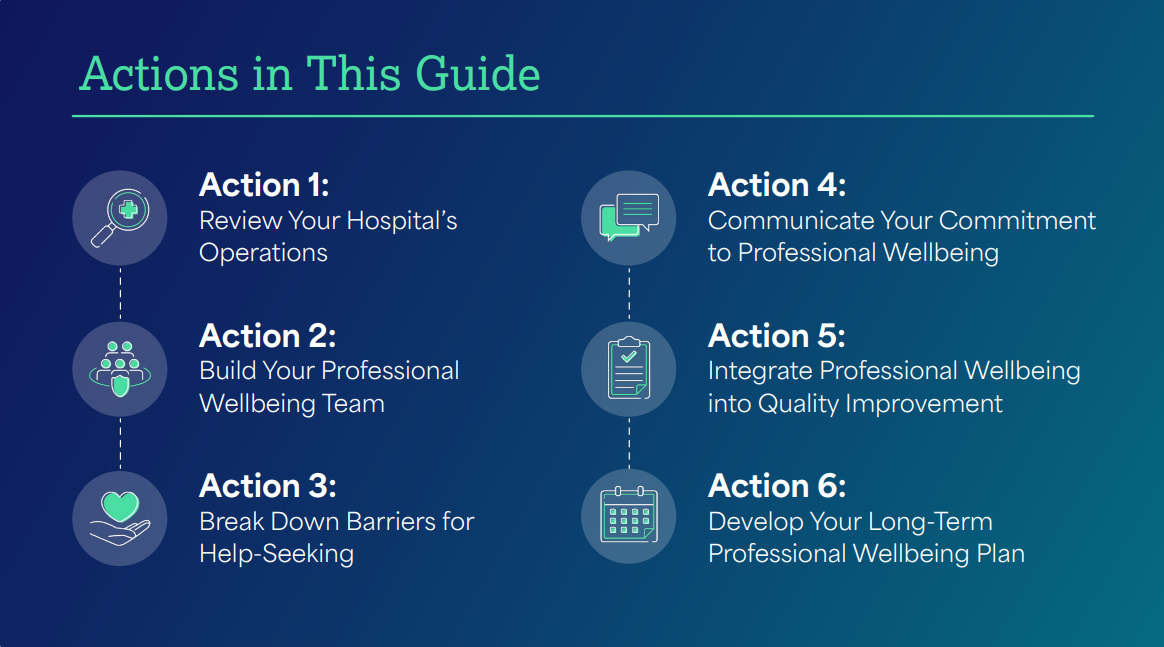
Share On Social!
Nearly half of healthcare workers say they often feel burned out.
That is why CDC’s National Institute for Occupational Safety and Health (NIOSH) recently launched the Impact Wellbeing Guide: Taking Action to Improve Healthcare Worker Wellbeing.
“The role of healthcare workers in taking care of all of us is absolutely vital to our society, to our economy, and to our culture. But our healthcare workforce needs to feel supported, too,” said Dr. John Howard, NIOSH director, in press release.
Let’s explore the guide, its six action steps, and how it can benefit Latino healthcare workers!
What is the Impact Wellbeing Guide?
NIOSH and the Dr. Lorna Breen Heroes’ Foundation designed the Impact Wellbeing Guide to help hospital leaders and executives accelerate or supplement professional wellbeing work in their hospitals at the operational level.

“Improving professional wellbeing for all healthcare workers is key to the success of hospitals and healthcare systems,” according to the CDC.
The guide has been real-world tested for usability by hospital leaders from six hospitals within the CommonSpirit Health system across the United States.
The key principles of the Impact Wellbeing Guide including using a systems approach and building trust through transparency and involving staff in decisions around wellbeing efforts.
The Impact Wellbeing Guide also includes 6 evidence-informed actions that are designed to improve the professional wellbeing of healthcare workers and strengthen hospital operations.
Step 1: Review Your Hospital’s Operations
The purpose of this action is to connect with colleagues within your organization to gather information about current efforts that support healthcare worker wellbeing.
“Reviewing your hospital’s current operations is an essential and foundational step to understanding how your hospital supports the wellbeing of healthcare workers,” according to the CDC.
Find an additional action resource here.
Step 2: Build Your Professional Wellbeing Team
This action calls for assembling a Professional Wellbeing Team that will lead efforts in your hospital in support of professional wellbeing.
“Building a Professional Wellbeing Team ensures that executive leadership commits time and resources to protect, improve, and sustain the professional wellbeing of healthcare workers,” according to the CDC.
Explore additional resources like worksheets and a wellbeing team role chart here.
Step 3: Break Down Barriers for Help-Seeking
This action calls for the review and update of hospital credentialing application questions and identify confidential ways for healthcare workers to seek support.
“Auditing and updating hospital credentialing questions removes barriers to care and sends a clear message to healthcare workers that your hospital supports their mental health,” the CDC states.
Download resources, including a checklist to audit credentialing applications, here.
Step 4: Communicate Your Commitment to Professional Wellbeing
The purpose of this action is to prioritize two-way communication with hospital staff about your wellbeing work.
“Clear, consistent, and open communication with staff is an essential part of professional wellbeing,” according to the CDC. “Communicating with your workforce generates buy-in, creates opportunities for staff to provide feedback, and prevents a disconnect across different departments in your organization.”
Find a communications plan outline, sample emails, and other helpful resources on this action here.
Step 5: Integrate Professional Wellbeing into Quality Improvement
This action aims to integrate professional wellbeing measures into an ongoing quality improvement project at your hospital.
“It helps ensure that quality improvement projects do not compromise professional wellbeing and rather measure the impact of these projects on the workforce,” the CDC states.
Find additional resources, including a list of professional wellbeing measures, here.
Step 6: Develop Your Long-Term Professional Wellbeing Plan
This action encourages the development of a professional wellbeing plan that reinforces your hospital’s commitment to professional wellbeing and creates sustainable change.
The key concept of this action is to “maintain an environment where healthcare workers thrive, it is essential to create a long-term Professional Wellbeing Plan that includes goals for individual support, measurement, and operational improvement.”
A professional wellbeing plan outline along with other resources and customizable materials can be accessed here.
Explore the complete the Impact Wellbeing Guide here.
“The Guide is an important component as we seek to ensure that hospital leaders have the right tools to provide a supportive environment for the healthcare workers who take such good care of our communities,” said Paul Raines, System SVP Behavioral Health at CommonSpirit Health.
Exploring Implicit Bias
Improving the professional wellbeing of healthcare workers is important.
So is addressing implicit bias.
Implicit biases — stereotypes that affect our understanding and decisions about others beyond our conscious control — lead to discrimination and health disparities.
Fortunately, implicit bias can be “rewired” for compassion for patients of color.
Download the free Salud America! Action Pack “Health Care Workers and Researchers: Find If You Have Implicit Bias and What to Do Next.”
“This Action Pack will help you see if you have implicit bias, learn from others who have overcome their own implicit bias, and encourage colleagues to learn about implicit bias, too,” said Dr. Amelie G. Ramirez, director of the Salud America! Latino health equity program at UT Health San Antonio, who created the Action Pack.
Explore More:
Mental HealthBy The Numbers
142
Percent
Expected rise in Latino cancer cases in coming years



